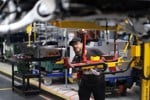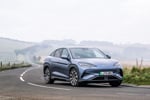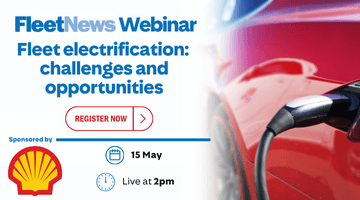The first Fleet News 2025 Strategy Forum put the spotlight on fleets’ five-year planning as UK businesses start the transition towards the ban on sales of new petrol/diesel by 2030.
Among the challenges discussed by an expert panel of fleets was how to engage key stakeholders, including getting buy-in from the top to accelerate change and persuading drivers to make the right choices.
Head of fleet James Buxton and fleet business development manager (EV) Kate Thompson from sponsors Audi gave an insightful overview about the challenges, barriers and possible solutions that a number of its key customers have shared, as they plan their transition to a zero-emission fleet by 2035.
Joining Buxton and Thompson on the discussion panel were:
- Lorna McAtear, fleet manager, National Grid
- Wayne Warburton, head of mobility, Siemens
- David Gibbin, Severn Trent Water Energy Flexibility Manager
- Kat Hawker, Severn Trent Water transport manager
- Ian Featherstone, knowledge manager at Energy Saving Trust
Fleets debated the role of plug-in hybrid (PHEV) technology as a stepping-stone to full battery electric (BEV), with Warburton revealing that, out of the 80 drivers on his fleet with a BEV, more than 80% previously had a PHEV.
One of the most complex issues to resolve is workplace charging infrastructure, understanding the charge point power required to meet the business needs and future proofing. Excellent advice was provided by McAtear, Hawker and Warburton, which can be heard on the webinar recording.
The panel was united on the importance of calculating total cost of ownership when comparing electric vehicles against diesel/petrol alternatives.
Due to time limitations and the huge interest from webinar delegates, several questions could not be answered on the day. They have been collated below with responses from panellists.
Thanks to Kat Hawker, Wayne Warburton, Ian Featherstone, James Buxton and Lorna McAtear for providing the answers.
You can still watch the Fleet2025 Strategy Forum: zero-emission fleets webinar.
Extended Q&A
One of the major stumbling blocks in our fleet is capital cost of vehicles and grade offerings. BIK is a larger benefit for those privileged with higher grade options. What are Audi's plans to assist the lower end of the spectrum and get more options?
There are more lower value BEVs coming to market in the near term, this will certainly be driven by the scale of the market growth – simply put more volume = less cost. Audi will launch the Q4 e-tron in the not too distant future which will be our first electric vehicle in the mid sized premium SUV segment.
A number of customers we are working with have introduced a trade up mechanism and have reported good uptake on both PHEVs and BEVs. In certain circumstances, drivers appear willing to contribute to the higher lease cost as often the BIK saving far outweighs their contribution. Another important area to review is TCO, often we see companies not including the NIC saving in their calculations – this can be significant especially on a large fleet.
Current costs of AFVs is excluding some employees from taking this option for a company car, as the cost is outside of the allowable vehicle cost for their salary band. How can this be addressed?
More lower value BEVs are coming to market, e.g. VW ID3, Merc EQA, and non-exec brand are increasing e.g. Hyundai, Kia etc. If you view these on TCO and include fuel costs and BIK these models are getting closer but agree, in general, are still more expensive.
It will take some time for the OEM to shift and offer better discounts for BEV as they have large investment costs but we estimate that by 2025 the ICE v BEV will be similar.
Moving to TCO-based allowances will help and we are finding more examples of where the vehicles work. But don’t forget NI contributions; currently these can equate to £1000 a year saving on mid-range fleet cars.
Operating a largely commercial based fleet (<3.5t) with the majority of vehicles travelling 30k miles p.a., viable options for AFVs seem minimal - how do the panel see this market developing to decarbonise?
The market will develop; I feel the small van market has come on quite a lot since 2017. What is lacking is the medium- large vans; the range is not close to what a commercial fleet needs. 2023 will be the year it all changes; I base his on the small van timeline start to finish.
This sort of mileage is a challenge. However, it depends on how consistent the daily mileage is and if the vehicles return to base. The choice of vans has been limited to relatively short range, smaller vans until now, but the latest models launched and announced for the next couple of years will enable more fleets to shift to electric vans. The number of rapid chargers is increasing at a pace and with fuel card options now available and growing their networks the option of en-route top ups (you don’t have to sit for 30-45 minutes if you only need another 40 miles) become more feasible.
Are there any views regarding the purchase of onsite office 50kwh+ chargers vs. leasing these? Private charging infrastructure is massively helpful yet installation for purchase is massively expensive and a difficult sell.
It is and upgrade costs may need to be factored in as well. However, rapids are usually only needed for very fast turnaround so it’s necessary to understand distance driven, total energy required and downtime available. A half-way house is 20-25kW DC chargers which although more expensive than AC are cheaper than rapids and will provide fast charging on a rapid charge capable vehicle.
A lot of this depends on whether the property is owned or rented (and if rented, then how long will the property be rented for). I have looked at this and the answer will vary depending on your own business models and whether it is cheaper for your company to borrow the money or to fund on a lease elsewhere. In my opinion, the decision here is very similar to whether you buy or lease your cars / commercial vehicles now.
Does Audi have any plans in place to help develop the public charging infrastructure?
We’re currently looking across the public charging landscape to ensure that infrastructure is available when and where our customers need it. We’re in regular discussion with many providers of public charging infrastructure and there’s a huge amount of investment and development planned over the next few years. We’re also currently assessing where strategic partnerships may be necessary to stimulate the infrastructure investment and access for VWG/Audi customers.
Views on 4 pence per mile HMRC Advisory Electricity Rate - is it too low?
This figure is about right, if you consider on average an electric car will do 3.5 miles approx. per kWh, so 100 miles works out around 4p per mile. That said, it needs to be reviewed as the electric uptake increases. Choosing where you charge is king; if you charge at home you can choose energy plans which are geared for electric cars, but if you use motorway service stations as a fast charge these tend to cost much more expensive and the 4p will not cover.
This is low. Typical pence per Kwh for home charging is 0.15 but we are now seeing low overnight charging options e.g. 0.05. If you charge roaming a lot and have to pay the typical rates of 0.35 pp/KWh, users would be out of pocket so having home charging and making sure vehicle is regular charged is a must.
It is low at a typical domestic rate. Ensuring drivers of BEVs are aware of cheaper tariffs as above may help them turn this round, as well as a reminder of the thousands they may save in BIK.
Yes and no. This year is still in such a state of flux and how HMRC have calculated the AER rate uses the same methodology as they do for diesel and fuel therefore it is correct. It is a challenge when we know some public sites are free, some are still very expensive. Winter driving versus summer driving has an impact on the cost per mile. It is probably 1-2ppm too low but that is primarily when you are in winter. All year round for the more economic EVs, it isn't too far off.
Would the panel recommend a five-year lease or an eight-year lease? The five-year seems to be expensive and the eight-year seems too long. Commercial vehicles doing 30k per year over eight years would be a massive mileage. What is the view?
We have chosen to purchase our commercials; some of this decision is down to the mileage and TCO. We haven’t found lease deals yet that can incorporate commercial mileage. If I was going to go lease, then I would go five years as eight is too long. In a market that’s constantly changing and improving, you don’t want to be holding an eight-year-old electric van. The unstable RV is causing some issue in the leasing world, once vans start hitting the second life market leasing deals will start looking more attractive. One thing is for sure the commercial van market is very much behind the curve and they need to catch up.
The danger with going for longer lease time is that this area of technology is changing rapidly and going for longer periods could see vehicle ranges and charging capabilities being out of date. Also, will the second-hand market want a vehicle that is five to eight years old with old tech? The residuals may be very low.
Eight years seems a long time for a highish mileage vehicle, particularly as higher mileage BEVs achieve cost parity with ICE much sooner. So far, the used van market has absorbed the relatively low range used vans available with strong RVs being achieved in the last couple of years, however I agree that RVs become far more uncertain with older vehicles.
I'm assuming you are talking commercials. With battery warranties extending out to eight years, fewer moving parts, better maintenance (lower), then the mileage almost becomes irrelevant and eight years could work if funders were willing to do that.
How do you see the activity between fleets and local authorities to support the switch for essential vehicles users, so they have the ability to charge an EV at home which is the lowest cost and most eco-friendly, when the majority of these type of drivers don’t have a driveway and rely on parking their vehicle on the street?
Local authority and fleets need to collaborate in order to solve this issue. What I think the authority lack is visibility of fleet operators and what they are planning. We are based in a large city, but our vehicles are not. They are spread across a lot of authorities. How can we get them on board, how can we tell them we want to deploy X amount of electric vehicles into their area? There needs to be some form of authority forum when fleet operators can submit future plans.
Agree, we are supporting local authorities apply for ORCS funding.
We currently allow our drivers to use company vehicles for private use alongside business. How is this handled with electricity and charging?
The most straightforward way is to pay the 4p AER for business use. It is possible to have the home charge point energy use monitored if a particular supplier is chosen for home installations. Then it’s a case of allocating costs between private and business mileage as per a fuel card. One to discuss with a couple of suppliers and see how this could work.
We don't treat this any differently to how we do currently with fuel and mileage reimbursement on diesels.
Do electric vehicles need less servicing than ICE vehicles and does this affect the TCO?
For our current electric fleet, we have found they still need a yearly service. However, the parts element is reduced for obvious reasons. We have found tyres are getting excessive wear vs the ICE vehicles.
An EV’s engine has 20 moving parts compared to 2,000 in an ICE (internal combustion engine) so your RV will need a lot less maintenance. For sure you still need brakes/tyres and it is a little early to tell how different these are, but data will become available in next months as we start to see early EV take-up starting to need services. Also, a lot of EVs don’t need a service early on unlike an ICE - e.g. no oil/filter change.
Yes, user experiences report lower maintenance costs and reduced brake wear due to use of regenerative braking particularly for vehicles driven in urban areas.
Yes - a lot less, so that is why you really need to consider the whole cost of the vehicle.
It would be interesting to gauge your thoughts on residual values and have you any data on realised residual values to support your views? What will Audi be doing to help maintain the RVs on e-tron product?
This is a well published area for the whole industry to focus on. As a brand, Audi are yet to see significant volumes of three-year-old vehicles return to the market. This will start to change in the next 18 months.
We are busy preparing our network focusing on ensuring we have the knowledge to correctly re-furbish vehicles and ensuing our sales teams are confident about discussing the technology with prospective customers - this work is ongoing and something we are investing heavily in.
Are any organisations looking at investing in charging infrastructure in staff car parks for employees, and how this links with overall power needs?
In the past organisations made a token point of installing one/two suppliers. Prior to Covid, sites were often seeing the need for slow chargers – 7kW - as most drivers had PHEVs. Now with the update of EVs, a more long-term review of this a priority as there is no ICE safeguard like a PHEV.




















Login to comment
Comments
No comments have been made yet.